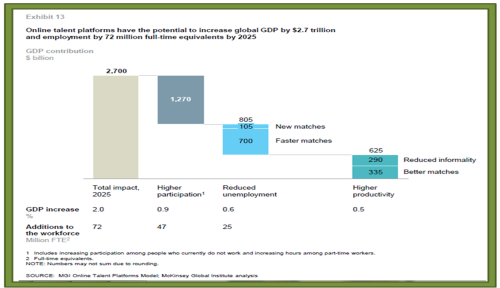Last week, I introduced you to Mary Meeker’s Internet Trends 2015 report, which I suggested should be required reading for HR.
This report, which really should have been titled, The Internet in 2015 is All About HR, shared important data points and analysis relating to basic HR functions and the impact the Internet is having on basic organization functions.
This week, I’d like to point out the McKinsey Global Institute’s new report is titled A Labor Market That Works: Connecting Talent With Opportunity in the Digital Age. Even if you only the read the Executive Summary, this is also well worth your time.
Transforming relationships in the gig economy
It’s full of employment-related data from the major global economies as it links those statistics to the growing impact of online talent platforms – and their potential — in the gig economy to transform both the employer/employee relationship and how workers find work and build economic opportunity.
It’s important information and their analysis of (mostly) Linkedin data is arresting.
The report is organized into three broad topics:
- Better, fast matching;
- Economic impact; and,
- Talent management for companies.
A focus on economic impact
All three topics could sustain a full report on their own, but I’ll focus on the second: Economic impact. The gig economy powered by online talent platforms, by their analysis, will be contributing $2.7 trillion to global GDP by 2025. They do the math by analyzing three channels of impact:
- Increasing labor force participation and hours worked among part-time employees;
- Reducing unemployment;
- Raising labor productivity.

This adds 72 million workers to the global workforce and adds a full 2 percent to the projected world GDP for 2025. The largest impact, $1.3 trillion, come from great labor participation and more hours worked.
Shortening job searches and creating matches that would not have been otherwise will lower unemployment rates, creating the second biggest impact at $805 billion. The third biggest impact is the increase of productivity through higher quality job matches and a shift to formal employment from informal grows global GDP by $625 billion.
Will 540 million people benefit by 2025?
But their analysis also shows that the positive impact of the gig economy is greater than dollars as 540 million people (nearly 70 percent more than the current population of the United States) will benefit from these new ways of connecting workers to work.
That’s big, right? And that’s only 10 years from now.

As an HR leader, are you concerned about the talent pipeline? Having trouble filling your current open positions? Wondering if the use of internet based solutions will produce better results? The real question may be, “How fast can I start implementing online talent platform solutions in order to connect workers to the work we have available?”
The report continues to make the economic case for the positive impact of internet enabled platforms by predicting their use could reduce public spending on labor market programs, allocating as much as $89 billion/year from unemployment benefits savings to education and vocational training programs to ensure a skilled talent pipeline.
McKinsey also predicts that online talent platforms may increase innovation, strengthen productivity and generally “improve the development of human capital across economies.”
Boiling down Big Data
This is Big Data at its best: Boiled down to useful constructs.
The full report is 100 pages. I recommend that you download it and take it section by section.
I think you’ll be glad you did.
This originally appeared on China Gorman’s blog at ChinaGorman.com.
